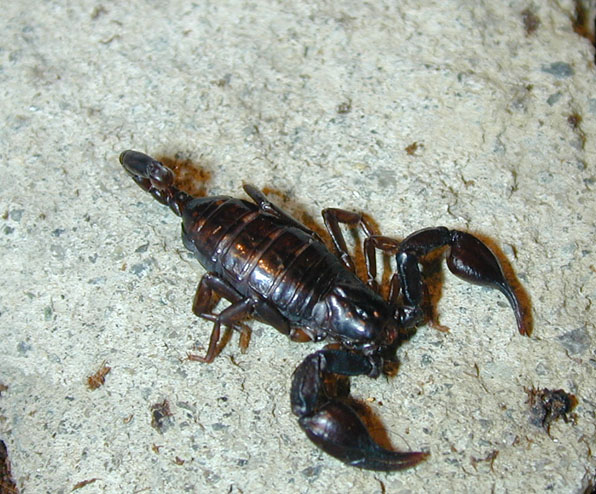|
Euscorpius
germanus
(C.L. Koch, 1837)
|
|

|
|
Common names:
No common name. All
Euscorpius were previously placed in the family Chactidae.
One subspecies of E. germanus was recently elevated to species
status, E. alpha.
Distribution:
Europe (Austria, Bosnia and
herzegovina, Bulgaria, Croatia,Italy (east of the river Adige (Etsch)),
Slovenia, Switzerland).
Habitat:
This species is found in mountainous areas
with high humidity. In some areas they are found above 2000 meters, and
some of these areas have an avarge annual temperature between 4 and 10
degrees C (in January, the temperature in some of these areas can drop to
minus 4). E. germanus is usually found under stones and under bark.
This species is rarly associated with human activities. Data on natural habitats in Southern Europe
wanted!
Venom:
Few medical data available, but data from
Italy suggest local effects only. Mildly venomous. Harmless scorpion,
which rarely will use its stinger.
Selected litterature:
Torregiani, F. & C. La
Cavera (1990). Puntura di scorpione (Euscorpius, sp.) in Italia e
rassegna dello scorpionismo [Scorpion sting (Euscorpius, sp.) in
Italy and scorpionism review.] Minerva Medica, vol. 81 (suppl. 2), pp.
137-145.
Crucitti, P. (1993). Distribution and diversity of Italian
scorpions. REDIA, vol. LXXVI (2), pp. 281-300.
Gantenbein, B, V. Fet,
M. Barker & A. Scholl (2000). Nuclear and mitochondrial markers reveal
the existence of two parapatric scorpion species in the Alps: Euscorpius
germanus (C. L. Koch, 1837) and E. alpha Caporiacco, 1950, stat. nov.
(Euscorpiidae). Revue Suisse de Zoologie, 107 (4),
843-869.
Braunwalder, M. E. 2001: Scorpions of Switzerland: summary of
a faunistic survey. 279-286. In V. Fet & P. A. Selden (eds.).
Scorpions 2001. In memoriam Gary A. Polis. British Arachnological Society.
Burnham Beeches, Bucks. xi + 404 pp.
On the Internet:
European
scorpions by Dr. Benjamin Gantenbein.
General:
This species is a small black scorpion
with dark legs. Adults measure 18-30 mm. It is a typical fossorial
scorpion with large, strong pedipalps, a stout body, short legs and a
short, thin tail (metasoma). See the Euscorpius
identification key for more details.
This species is rarly kept in captivity, as it is not so "domesticated"
as many of the other species of Euscorpius. Few commersial
suppliers deliver this species (and other Euscorpius).
Euscorpius germanus photo by Jan Ove Rein
(C) | 
